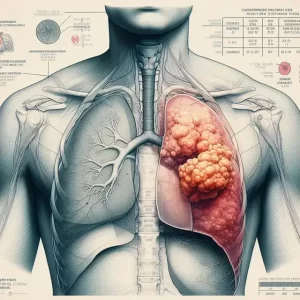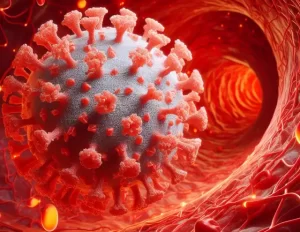Nature Series Review: Trends in FDA Approval of Cancer Therapies Since the 21st Century
- Brief Intermittent Exercise Reduces Heart Disease and Death Risk
- Personalized Lung Tumor Chips Assess PD-1 Therapy Response
- Study Shows Prior Infection Offers Strong Immunity to Original COVID-19 Strain
- Chinese Food Products Dominate Korean Tables Amid Safety Concerns
- Early Detection of Hypopharyngeal Cancer Possible with Saliva Diagnosis
- EB Virus Could Be Infected by Kiss: A Hidden Threat Linked to Cancer
Nature Series Review: Trends in FDA Approval of Cancer Therapies Since the 21st Century
- AstraZeneca Admits for the First Time that its COVID Vaccine Has Blood Clot Side Effects
- Was COVID virus leaked from the Chinese WIV lab?
- HIV Cure Research: New Study Links Viral DNA Levels to Spontaneous Control
- FDA has mandated a top-level black box warning for all marketed CAR-T therapies
- Can people with high blood pressure eat peanuts?
- What is the difference between dopamine and dobutamine?
- How long can the patient live after heart stent surgery?
Nature Series Review: Trends in FDA Approval of Cancer Therapies Since the 21st Century.
The field of cancer treatment has changed dramatically since the end of the last world, resulting in substantial improvements in outcomes for cancer patients.
Recently, researchers from the Office of Tumor Diseases in the Center for Drug Evaluation and Research of the US FDA published a review paper titled: Trends in the approval of cancer therapies by the FDA in the twenty-first century in Nature Reviews Drug Discovery, a review journal under Nature .
This review summarizes the trends of US FDA-approved cancer treatment products from January 2000 to October 2022, and categorizes these products according to their mechanism of action and primary target.
Since the 2000s, the rate of approval for oncology indications has increased over this time period due to the advent of targeted therapies, as has the rate of introduction of new treatments.
Kinase inhibitors are the product category with the largest number of approved products and indications, while immune checkpoint inhibitors were not approved for the first time until 2011, but the number of approved products is second only to kinase inhibitors. The review also looks at future trends in product development for cancer treatment and the impact of new treatments and technologies.

Research on cancer treatment products dates back to the early 20th century (1900s) , when the term ” chemotherapy ” was coined and some initial experiments showed therapeutic promise.
But it wasn’t until 1949 that the FDA approved the first chemotherapy drug, nitrogen mustard ( Mustargen ) , to treat non-Hodgkin’s lymphoma, and its discovery was based on Allied research on chemical weapons during World War II.
In the decades since, cancer treatment products have been limited to systemic cytotoxic drugs that affect rapidly dividing cells, some of which are also rapidly dividing in addition to cancer cells, and these chemotherapeutic drugs are often highly toxic.
Until the late 1990s and early 2000s, the cancer treatment landscape changed dramatically with the advent of targeted therapies designed to selectively kill cancer cells by exploiting their genetic predisposition .
In 1998, trastuzumab (Her2 monoclonal antibody) was approved for the treatment of breast cancer; in 2001, imatinib (a small molecule inhibitor of BCR-ABL) was approved for the treatment of chronic myeloid leukemia.
Their approval is considered to usher in the era of precision oncology.
Since the beginning of the 21st century, the treatment effect of cancer patients has been further improved.
Taking the United States as an example, from 1995 to 1999, the age-adjusted death rate of all cancers in the United States was 206 per 100,000 people, but in 2014-2018, this ratio dropped to 155.5 per 100,000 people.
The largest single-year decline in overall cancer mortality from 2016-2017 was 2.2%, driven by a rapid decline in lung cancer mortality, in part due to immune checkpoint inhibitors (ICIs) and other new targeted therapies approved.
Overall Trends in Oncology Approvals
Between January 1, 2000, and October 31, 2022, a total of 206 different oncology products received 573 approvals for oncology indications, of which 50 were cytotoxic drugs, 277 were targeted drugs, and 246 were targeted biologics.


These products are divided into 99 subclasses, which are organized into 31 classes, which are organized into 3 groups ( cytotoxic drugs, targeted drugs, targeted biologics ) .
Approval rates rose sharply throughout the analyzed period. The average annual number of approvals per five-year period has increased from 7.4 per year in 2000-2004 to 56 per year in November 2017-October 2022, a growth rate of 757%.
Since 2009, this growth trend has been driven entirely by increased approval rates for targeted drugs and targeted biologics, while approval rates for cytotoxic drugs have been considerably lower and declined slightly during the analyzed period.
From 2000 to 2019, the approval rate of targeted drugs was slightly higher than that of targeted biologics, but from 2020 to 2022, the approval rate of targeted biologics exceeded that of targeted drugs.
The number and timing of therapeutic product approvals varied by disease site throughout the analysis period.
Breast cancer, leukemia, and lymphoma all received new approvals throughout the analysis period, with approval rates generally increasing for each of these cancer types since 2014.
For brain and head and neck cancers, the number of approvals was low throughout the analysis period, while for skin and thyroid cancers, after no new product approvals in 2000-2010, the number of approvals increased significantly each year in recent years.
Since 2015, lung cancer, lymphoma, genitourinary system cancer, breast cancer, and leukemia have received the most approvals, with ≥35 approvals for each of these cancers in the past 8 years.

Approval Trends in Therapeutic Product Categories
All approved products can be divided into three groups (cytotoxic drugs, targeted drugs, targeted biologics) , which are further divided into 31 categories according to the mechanism of action.
As can be seen from the figure below, kinase inhibitors (which are targeted drugs) have the highest number of approvals, with new approvals throughout the analysis period, the earliest of which was imatinib in 2001 .
The category with the second highest number of approvals is immune checkpoint inhibitors (belonging to targeted biological agents) .
The earliest or approved drug of this type was ipilimumab in 2011 . Kinase inhibitors and immune checkpoint inhibitors will have the same number of approvals in 2022 (9), compared with 91 and 82 in the previous five years.
Taken together, these results demonstrate the enormous impact that immune checkpoint inhibitors have had since their first approval in 2011, and also the continued importance of kinase inhibitors across the entire oncology therapeutic product spectrum.

Since 2000, 5 different products have each received 12 or more approvals, 3 of which are immune checkpoint inhibitors ( pembrolizumab, nivolumab, and atezolizumab) , 1 One is a vascular endothelial growth factor inhibitor (bevacizumab) , and one kinase inhibitor (imatinib) .

Trends in Single Drug and Combination Drug Approvals
Since 2000, single-agent indications have accounted for about two-thirds (364/551) of oncology product approvals , with the remaining about one-third (187/551 ) in combination.
Combination drugs accounted for the highest proportion of cytotoxic drugs approved (52%) , followed by targeted biological agents (43%) , and finally targeted drugs, and the approved indications of combined drugs accounted for only 23% of the approvals in this group.
Certain product classes have a higher percentage of approvals as combinations than as single agents, such as asparagine depleters, 100% approved as combinations, microtubule inhibitors (80%), anti – VEGF ( 76%) , anti-tumor-associated antigen antibodies (75%) , and nuclear export inhibitors (67%) .
In some diseases, the approval rate of combination drugs is higher than that of single drugs, such as multiple myeloma, 66% of the approvals are combination drugs, colorectal cancer (65%), breast cancer (63% ) , brain cancer (60%) and head and neck cancer (57%) .

Trends in Approval Pathways
The Accelerated Approval (AA) pathway was introduced in 1992 as an alternative to traditional approval for product approval, initially focused on expediting product development during the AIDS crisis.
Now this pathway serves as an accelerated program for products targeting serious or life-threatening diseases , including cancer , allowing transformative products to be approved years earlier. However, approved products or indications may be withdrawn if their clinical benefits are not subsequently proven.
As of October 31, 2022, a total of 18 accelerated approval products have been withdrawn, all of which are targeted drugs or targeted biologics, including 7 immune checkpoint products, 5 kinase inhibitors, and epigenetic drugs. There are 2 modifiers.
Throughout the analysis period, 71% of approvals (407/573) used the regular approval route and 29% (166/573) used the accelerated approval route.
The total number of accelerated approvals has increased in recent years, but this reflects an overall increase in the approval rate of therapeutic products over the analysis period, rather than an increase in the proportion of accelerated approvals used in oncology.
Among the accelerated approvals, targeted biologics had the highest proportion (31%) , targeted drugs had a slightly lower proportion (29%) , and cytotoxic drugs had the lowest proportion (20%) .

In different product categories, the proportion of accelerated approval and regular approval varies greatly.
There are 12 types of products without any accelerated approval, and 2 types of products are all accelerated approval, namely protein synthesis inhibitors and RAS inhibitors.
Among the categories with at least 10 approvals, accelerated approval use was highest in epigenetic modifiers (42%) , targeted cytotoxic drugs (41%) , antimetabolites (40%) , and immune checkpoint inhibition agents (39%) .
Kinase inhibitors had the highest number of accelerated approvals (58) , but accelerated approval progressed to 32% of approvals in the kinase inhibitor category.
In different cancer types, the approval pathways used by approved drugs are also different. Among the 18 cancer classifications, 16 are mainly routine approval.
The cancer types most commonly used for accelerated approval were lymphoma (40%) , brain cancer (40%) and leukemia (34%) , while the lowest were blood cancer (11%) , head and neck cancer (13%) and breast cancer ( 19%) .

Summary
The pace of development of oncology therapeutic products has increased since 2000.
The development of targeted drugs and targeted biologics has been rapid, while the development of cytotoxic drugs has slowed down. Innovation in oncology therapeutics has increased, as measured by the rate of introduction of new product subcategories.
Kinase inhibitors remain the dominant product class, but immune checkpoint inhibitors have had a considerable impact since the first immune checkpoint inhibitor , ipilimumab , was approved in 2011. Compared with all other product subcategories, the number of approved indications for anti-PD-1 antibodies stands out .
The use of biomarkers in oncology indications has grown steadily since 2009, but this pace may be slower than expected given the expansion of precision medicine in recent years.
Single-drug approvals were the most common, but combinations accounted for 34% of approvals.
The increased number of accelerated approval pathways in recent years reflects the overall growth of oncology products, with the use of accelerated approval remaining relatively stable at an average of 31% throughout the analysis period .
Overall, the pace and innovation of oncology therapeutic product development has accelerated so far in the 21st century.
These trends are likely to continue with further innovations in many promising approaches and fields, leading to further improvements in tumor therapy and cancer patient outcomes.
Paper link :
https://www.nature.com/articles/s41586-023-06199-x
Nature Series Review: Trends in FDA Approval of Cancer Therapies Since the 21st Century
(source:internet, reference only)
Disclaimer of medicaltrend.org
Important Note: The information provided is for informational purposes only and should not be considered as medical advice.



